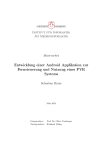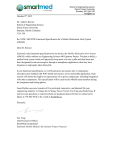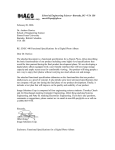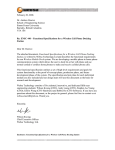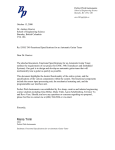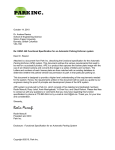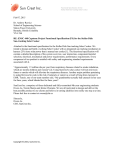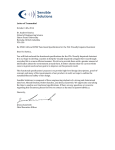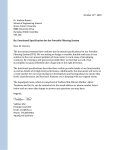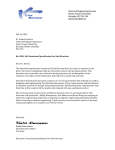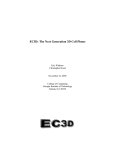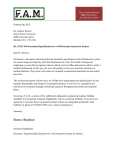Download Home Air Monitor - Simon Fraser University
Transcript
Home Air Monitor October 4, 2014 Dr. Andrew Rawicz School of Engineering Science Simon Fraser University Burnaby, BC V5A 1S6 Re: ENSC 440 Functional Specification for Home Air Monitor (H.A.M) Dear Dr. Rawicz, Please accept the following functional specification document for our Home Air Monitor project. Our goal is to create a cost efficient way to monitor dust and pollutant levels within a household space, and to provide alerts for users when air quality in an area becomes non ideal. This design consists of a sensor and Wifi capable processing system, communicating with an Android mobile application to alert the user. The purpose of this document is to provide an overview of the functionality that the monitoring system will have. This will assist us in the way we design our project, along with solving problems when they occur. We will be using this document throughout the course of the project as a reference for our goals and requirements for the overall project. Our team consists of three dedicated members that have now joined to form the company Clean Space. We have Joanne Leong, Peterson Poon, and Elaine Chiang, all fourth year Engineering students at Simon Fraser University. Should you have any concerns about these functional specifications, please feel free to contact me at [email protected]. Sincerely, Elaine Chiang Chief Executive Officer Clean Space Enclosure: Functional Specification for Home Air Monitor Home Air Monitor A cleaner, healthier home Project Team: Elaine Chiang Joanne Leong Peterson Poon Contact Person: Elaine Chiang ([email protected]) Submitted To: Dr. Andrew Rawicz Steve Whitmore School of Engineering Science Simon Fraser University Issued Date: October 10, 2014 Revision: 1.1 © 2014, Clean Space i Hoe Air Monitor Executive Summary With pollution being released in the air increasing daily, certain measures must be taken to protect our homes and ourselves. For many of us, the majority of our lives are spent indoors in locations such as school, work, and homes. In these environments, poor ventilation, mold, dust, and pollution can all play major roles in our respiratory health and well-being. At Clean Space, we feel that more proactive actions need to be taken to improve the air we come into contact with on a day-to-day basis. The objective of Clean Space is to create a device that allows the user to take control of pollutant levels in their living space by monitoring air intake areas and thus, prevent pollutants from entering their home in the first place. This device will observe the dust as it crosses a filtration device, and be able to alert the user on their mobile device when a filter has become too dirty to continue filtering effectively. Not only will this eliminate the dust that enters ventilation systems at home, it will also reduce the cost of premature filter changes and cleaning time. The development of this project will be done in three stages: two development stages to create the device, and a final production stage to make final adjustments. The stages are broken down as follows: Stage 1 - Proof of Concept Stage ● Build a system that allows the sensor and mobile device to communicate ● Create a mobile application that can display particle data from the sensor Stage 2 - Ongoing Development Stage ● Research and test to find threshold level of a healthy living space ● Package device into a more compact device ● Continue mobile application development to make it as user friendly as possible The end of stage two should be delivered no later than November 17th, 2014 to give adequate time for the final production stage. The HAM system will comply with safety regulations, and should be able to provide a monitoring system for a living space without interfering with existing systems. This following document will provide detailed functional specifications outlined for our system, along with the main sub systems. It is intended for use by designers, developers, testers for this product when necessary. © 2014, Clean Space ii Home Air Monitor Table of Contents Executive Summary .............................................................................................................................. ii Table of Contents.................................................................................................................................. iii List of Figures .......................................................................................................................................... v Glossary ..................................................................................................................................................... v 1. Introduction ....................................................................................................................................... 1 1.1 Scope of specification ............................................................................................................................... 1 1.2 Target audience .......................................................................................................................................... 1 1.3 Classification................................................................................................................................................ 1 2. System Requirements ..................................................................................................................... 2 2.1 System overview ........................................................................................................................................ 2 2.1.1 Development stage 1 - Proof of concept ......................................................................................... 4 2.1.2 Development stage 2 - Ongoing development stage .................................................................. 5 2.1.3 Development stage 3 - Final product stage .................................................................................. 5 2.2 General requirements .............................................................................................................................. 6 2.3 Electrical Requirements .......................................................................................................................... 6 2.4 Environmental Requirements ............................................................................................................... 6 2.5 Safety and Sustainability Requirements ........................................................................................... 6 2.6 Physical Requirements ............................................................................................................................ 6 2.7 Reliability and Durability Requirements .......................................................................................... 7 2.8 Usability Requirements ........................................................................................................................... 7 3. Microcontroller Requirements .................................................................................................... 7 3.1 General Requirements ............................................................................................................................. 7 3.2 Physical Requirements ............................................................................................................................ 7 3.3 Usability Requirements ........................................................................................................................... 8 3.4 Electrical Requirements .......................................................................................................................... 8 3.5 Reliability Requirements ........................................................................................................................ 8 3.6 Calculation Requirements ...................................................................................................................... 8 4. Optical Sensor Requirements ....................................................................................................... 8 4.1 General Requirements ............................................................................................................................. 8 4.2 Physical Requirements ............................................................................................................................ 8 4.3 Usability Requirements ........................................................................................................................... 8 4.4 Electrical Requirements .......................................................................................................................... 9 4.5 Reliability Requirements ........................................................................................................................ 9 © 2014, Clean Space iii Home Air Monitor 5. Circuitry Requirements .................................................................................................................. 9 5.1 General Requirements ............................................................................................................................. 9 5.2 Physical Requirements ............................................................................................................................ 9 5.3 Usability Requirements ........................................................................................................................... 9 5.4 Electrical Requirements .......................................................................................................................... 9 5.5 Reliability Requirements ........................................................................................................................ 9 6. Battery Requirements................................................................................................................... 10 6.1 General Requirements .......................................................................................................................... 10 6.2 Physical Requirements ......................................................................................................................... 10 6.3 Usability Requirements ........................................................................................................................ 10 6.4 Electrical Requirements ....................................................................................................................... 10 6.5 Reliability Requirements ..................................................................................................................... 10 7. Wi-Fi Security Requirements ..................................................................................................... 10 7.1 General Requirements .......................................................................................................................... 10 7.2 Usability Requirements ........................................................................................................................ 11 7.3 Reliability Requirements ..................................................................................................................... 11 8. Mobile Application Requirements ............................................................................................ 11 8.1 General Requirements .......................................................................................................................... 11 8.2 Usability Requirements ........................................................................................................................ 11 8.3 Reliability Requirements ..................................................................................................................... 12 9. User Manual ...................................................................................................................................... 12 9.1 General Requirements .......................................................................................................................... 12 9.2 Usability Requirements ........................................................................................................................ 12 10. System Test Plan .......................................................................................................................... 12 10.1 Hardware Test Plan ............................................................................................................................. 12 10.2 Software Test Plan ............................................................................................................................... 13 11. Conclusion ...................................................................................................................................... 14 12.References ....................................................................................................................................... 15 © 2014, Clean Space iv Home Air Monitor List of Figures Figure 1: High level system block diagram ............................................................................... 2 Figure 2: Conceptual schematic of the Home Air Monitor ...................................................................... 3 Figure 3: Conceptual design for positioning of HAM in filtration device .......................................... 3 Figure 4: Mobile application prototype done on Fluid UI ....................................................................... 4 Glossary HAM MCU Wi-Fi API Home Air Monitor Microcontroller Unit Wireless Fidelity Application Programming Interface © 2014, Clean Space v Home Air Monitor 1. Introduction While there are existing methods of monitoring living space cleanliness such as using air purifiers or referring to the air quality index of a city, we at Clean Space believe that there are more proactive measures that can be taken to improve our personal indoor health. We aim to create an air quality management device that allows users to monitor the dust and pollutants in less frequented areas of their homes. Our main target is to monitor filters of air intake vents with filtration systems. (Figure 3) By giving alerts to the user when a filter is too dirty, we can thus create a way to stop these pollutants before it enters the ventilation system of an indoor space in a cost effective way. Providing these alerts on a device that is often close to the user will also add to the convenience and usability of our system. The solution Clean Space is offering will not only reduce the cost and time of premature filter changes, it will most importantly produce a better air quality environment for our users to live in. The requirements for the HAM proposed by Clean Space are outlined in this functional specification document. 1.1 Scope of specification The scope of this document is to outline the functional requirements of the HAM system. This document outlines general specifications of the entire system, hardware requirements including the sensor and processor, the Wi-Fi communication requirements, and the software mobile application requirements. These specification details have been discussed with Clean Space to provide a guideline to design the most reliable and user-friendly product possible. Clean Space will be referring to this document throughout development stages to ensure it adheres to all regulations and goals. 1.2 Target audience This functional specification is intended for all members of Clean Space. We will be referring to this document throughout each stage of our development to ensure our final product matches our predefined regulations and requirements. This document will also assist in marketing after our final production stage is complete, and for the creation of an idealized monitoring system. 1.3 Classification The functional requirement specification is shown as follows: [Rn-p] © 2014, Clean Space 1 Home Air Monitor ‘R’ is the abbreviation for requirement, ‘n’ is the functional requirement number and ‘p’ stands for one of the development phases listed below: I. Proof of Concept II. Ongoing Development III. Final Production 2. System Requirements The general requirements and specifications for the complete HAM system are outlined in this section. Additionally, the future specifications after our prototype are also outlined here. 2.1 System overview This system overview section defines how each component within the system will communicate. (Figure 1) It will also outline the potential design of HAM along with the predicted placement location within a filtration system. It will also show the mobile application prototype and the functionality of it. Figure 1: High level system block diagram The HAM will have a casing to encompass the MCU and an external battery to power the portable device as shown in Figure 2. A USB port will be on the side of the device in order to recharge the battery and general debugging during the development cycle. When © 2014, Clean Space 2 Home Air Monitor applying the device to a household appliance, the device will be placed to the side of the screen filter of the appliance as shown in Figure 3. Figure 2: Conceptual schematic of the Home Air Monitor Figure 3: Conceptual design for positioning of HAM in filtration device © 2014, Clean Space 3 Home Air Monitor On the software side, the mobile application will have functionality such as seeing the sensors that are connecting through Wi-Fi to the mobile device. It will also be able to show the details of a sensor when selected, and finally have an edit option to change the name or size of the area that is being monitored. (Figure 4) In the future, a camera option will also be added to allow the user to see where exactly they placed HAM. Figure 4: Mobile application prototype done on Fluid UI to outline how sensors, details, and edit features will be displayed. [2] The HAM system can be broken down into three main components, all of which can be designed, implemented, and tested separately before integration. The three components are composed by the sensor to collect data, the processor to make calculations, and the alert mechanism, which is done through a mobile device. For our prototype, we have broken down development into three stages. 2.1.1 Development stage 1 - Proof of concept The main purpose of the Home Air Monitor is to be able to provide an alert for the user on a mobile device when the dust sensor picks up a reading that is higher than the threshold for a healthy living space. Thus, the first stage of our project is to be able to create a system © 2014, Clean Space 4 Home Air Monitor that can communicate particle data between the sensor, processor, and mobile device. We will begin by creating the circuitry required to turn on the optical sensor and collect readings from it. Next, the processor will be set up to be able to store and process data passed in by the sensor. Finally, we will develop a mobile application that can communicate with the processor, and display the collected data on the mobile device. To allow for maximum mobility and flexibility with where the sensors are placed within a household, Wi-Fi signal will be used to communicate between the processor and the mobile device. For this stage, we will just need the mobile phone and processor to be on the same Wi-Fi network. At the end of this stage, we should have a compact system that can be placed on the inside of a filtration device, which can attain readings and send data to a mobile device where it can be displayed. 2.1.2 Development stage 2 - Ongoing development stage In the ongoing development stage, we will fine-tune our system to conserve battery and to give more accurate alerts to the user. We can achieve this by adjusting the amount of samples the sensor takes during a day, and by researching and conducting test trials to determine a particle threshold for what is considered to be a healthy home. To minimize the physical size of our system, we will also develop our own copper circuit board to use in place of the breadboard used in the proof of concept stage. On the software side, we will be working on making the mobile application more informative by creating the layouts to display collected dust particle data, and also adding features for the user such as naming sensors, edit features, and the alert feature that only signals the user when appropriate. At the end of this stage, we should see a more energy efficient process that only alerts the mobile device when a filter should be changed depending on our pre set threshold levels. Furthermore, the mobile application should be in a functional stage, allowing data to be displayed, fields to be edited, and alerts to be shown, all in a user-friendly manner. 2.1.3 Development stage 3 - Final product stage In the final production stage, we will work on creating something to contain the circuit and processor, while making the sensor still accessible to the environment. We will also be working on the look and feel of the mobile application, testing it with real users, and making modifications to sync the sensors to the phone in a quick and easy way. © 2014, Clean Space 5 Home Air Monitor At the end of this stage, our hardware system should be compact and neatly contained. Our software portion should be easy to use, and able to display and alert dust data relevantly. 2.2 General Requirements [R1-I] [R2-I] [R3-I] [R4-II] [R5-II] [R6-II] [R7-III] [R8-III] Communication will be from the sensor, to processor, to mobile device. HAM system should not interfere with any other devices at any time. HAM system must contain all electronic components that are CSA approved. HAM system must be compatible and adaptable to any system that requires observation. HAM system must be able to collect data in any area provided there is free air flow. The user should be able to define the area size of which HAM is sampling in. The HAM system should alert the user when a filter change is needed. The retail price of system alone will be less than CDN$100 2.3 Electrical Requirements [R9-II] [R10-II] [R11-III] [R12-III] The power provided should be sufficient to power up all the components of HAM system. All components of the monitoring system must have operating voltage of 5V. The power supply must be sufficient in powering the system for at least one week without recharging. The power supply must be eco-friendly and rechargeable. 2.4 Environmental Requirements [R13-III] [R14-III] [R15-III] HAM system should be able to withstand heat inside ventilation devices. HAM system should be lightweight. HAM system should be easily set up and removed. 2.5 Safety and Sustainability Requirements [R16-II] [R17-II] [R18-II] HAM system will be properly insulated and not overheat. HAM system will not contain any materials that cannot be disposed of safely. HAM system will have no jagged edges. 2.6 Physical Requirements [R19-II] HAM system will be contained in a compact box no larger than 0.5 cubic feet. © 2014, Clean Space 6 Home Air Monitor [R20-II] [R21-II] HAM system will have no loose wires outside of the box. HAM system will not be bulky or an awkward shape. 2.7 Reliability and Durability Requirements [R22-II] [R23-III] [R24-III] [R25-III] Power system for HAM should relatively accessible for recharge. HAM system should be weather resistant and waterproof. HAM system should be durable for normal daily usage and shall not show signs of wear. HAM system will not excessively dissipate heat that might damage the system or surroundings. 2.8 Usability Requirements [R26-III] [R27-III] [R28-III] [R29-III] [R30-III] [R31-III] HAM system will be user friendly and self explanatory even if the user has no previous knowledge of the system HAM system must be easy to install into existing filtration devices. HAM system must be easy to uninstall from existing filtration devices. HAM system must be easy to repair. The user must be able to use the mobile application easily. The user must have the ability to change HAM system settings through the mobile device. 3. Microcontroller Requirements 3.1 General Requirements [R32-I] [R33-II] [R34-II] Serve as a connection bridge between sensor and cell phone software Be able to process dust data and perform necessary calculations Connect to Wi-Fi network 3.2 Physical Requirements [R35-I] [R36-I] [R37-I] [R38-II] [R39-III] Supply voltage that is suitable to power the sensor Have some sort of Wi-Fi component Have programmable Input/Output pins Should be compact enough to be conveniently portable Will be able to function under reasonably high temperature conditions (i.e. work close to a furnace) © 2014, Clean Space 7 Home Air Monitor 3.3 Usability Requirements [R40-I] [R41-II] Short setup time so the system can be started quickly Have reasonable power consumption so the system does not need to be recharged often 3.4 Electrical Requirements [R42-I] [R43-II] [R44-II] MCU should be able to output a 5V Vcc to power the sensor Should have some sort of analog input to get the output voltage from the sensor Controllable output pin to trigger optical sensor power 3.5 Reliability Requirements [R45-II] Will transmit information from the sensor to the mobile application without significant value errors 3.6 Calculation Requirements [R46-II] [R47-II] Capable of basic mathematical calculations Calculations should not take significant processing power and time 4. Optical Sensor Requirements 4.1 General Requirements [R48-II] [R47-II] Be able to measure the amount of dust in an area Sensor must have straightforward usage and easy manipulation of features 4.2 Physical Requirements [R48-II] [R47-II] Small enough to be a part of a portable system Withstand above average temperatures for usage in close proximity to a furnace 4.3 Usability Requirements [R48-I] Measures discretely to not bother users © 2014, Clean Space 8 Home Air Monitor [R49-II] [R50-I] Setup does not require a significant amount of time Measuring time is quick 4.4 Electrical Requirements [R51-I] [R52-II] Does not require significant supply power Does not need to constantly be ‘on’ 4.5 Reliability Requirements [R53-II] Provide verifiable and accurate readings of dust level in a particular area 5. Circuitry Requirements 5.1 General Requirements [R54-I] [R55-II] Provide necessary circuitry and electronic components to the data sensor Easy to quickly setup 5.2 Physical Requirements [R56-I] [R57-I] Can be easily hidden within a box or container Wiring does not overwhelm the circuit 5.3 Usability Requirements [R58-I] Only used as support and connection for the system 5.4 Electrical Requirements [R59-II] Electrical components set up such that the sensor receives the correct current and voltages 5.5 Reliability Requirements [R60-II] Should not disrupt operation of other components of the system such as the Arduino and sensor © 2014, Clean Space 9 Home Air Monitor 6. Battery Requirements 6.1 General Requirements [R61-I] [R62-I] [R63-I] Able to power the Arduino without needing to connect to a wall outlet Rechargeable to not produce additional waste with disposable batteries Does not interfere with the operations of the rest of the system 6.2 Physical Requirements [R64-III] [R65-III] Small enough to be a part of a portable system Does not generate excessive heat 6.3 Usability Requirements [R66-I] Does not require any additional setup, should just be able to plug it into the Arduino and power it 6.4 Electrical Requirements [R67-I] [R68-I] Should be able to output a 5V Vcc to power the MCU Generates a maximum of 1.0 amperes to MCU 6.5 Reliability Requirements [R69-I] [R70-I] Should have a decent charge to power the system Battery should have rechargeable capability 7. Wi-Fi Security Requirements 7.1 General Requirements [R72-I] [R73-I] [R74-II] [R75-III] All local HAM systems are able to connect to the monitor application locally through Wi-Fi HAM systems will be able to detect the Wi-Fi network if it is inside the range of the Wi-Fi transmitter Each individual HAM system will be assigned a separate IP when connected to the Wi-Fi network HAM systems should not have access to another HAM system through the connected Wi-Fi © 2014, Clean Space 10 Home Air Monitor [R76-III] HAM systems will not modify and emit any interference signal that may disable the Wi-Fi network 7.2 Usability Requirements [R77-I] [R78-I] [R79-II] [R80-III] HAM systems will be able to detect the Wi-Fi network if it is inside the range of the Wi-Fi transmitter Wi-Fi settings are configurable to the user’s network requirement Wi-Fi security should support all existing encryption types User is able to remove an existing Wi-Fi network 7.3 Reliability Requirements [R81-III] [R82-III] [R83-III] Configuring and modifying Wi-Fi on HAM system will not interfere with other devices connected locally Wi-Fi connection should be able to sustain for long period of time without interruption Data transfer between the HAM system and the Wi-Fi network should have acceptable throughput range 8. Mobile Application Requirements 8.1 General Requirements [R84-I] [R85-I] [R86-I] [R87-I] [R88-II] [R89-II] [R90-II] [R91-III] [R92-III] Mobile application is able to launch successfully on an android device version up to 4.4.4, and to support API 15 and above User is able to close application and return to home screen User is able to install the application successfully User is able to uninstall the application successfully Mobile application will support a portrait position Notifications of the HAM system are displayed on the application and able to alert the user Application will be able to support up to multiple HAM devices Mobile application will have a user account to store data Application will have an indicator for the battery status of the HAM system 8.2 Usability Requirements [R93-I] Application is easy to use and navigate © 2014, Clean Space 11 Home Air Monitor [R94-II] [R95-II] Application interface follows basic android application design standards [1] Application will include a brief tutorial on how to use when first launch 8.3 Reliability Requirements [R96-I] [R97-I] [R98-II] [R99-III] [R100-III] Application does not introduce any latency to the mobile device performance Application is able to store settings configured by the user after restarting Application will provide error codes and crash logs if there are unexpected errors Application will not disrupt and use up the mobile device resources when running in the background Application does not interfere with other features of the mobile device 9. User Manual 9.1 General Requirements [R101-III] [R102-III] User manual will have a step-by-step tutorial to setup one HAM system and connect it to a mobile application User manual will be accessible online and include a hardcopy with the device 9.2 Usability Requirements [R103-III] [R104-III] User manual contains simple and clear instructions and is intended for users with minimal background experience User manual will be available in English and French 10. System Test Plan 10.1 Hardware Test Plan To test the hardware portion of this system, the individual pieces that make up the system will each need to be tested to ensure each component is reliable. Overall testing of all hardware components working together will be done afterwards. © 2014, Clean Space 12 Home Air Monitor The Arduino will have to be tested to ensure that it can successfully connect to the Wi-Fi in an area, and that the analog and digital pins can read and write data. The Vcc of the Arduino will need to be confirmed to be 5V in order to power the sensor. Testing will also be done with mobile network tethering and by connecting the Arduino to a network. The sensor will be tested to ensure that data can be transmitted to the Arduino through an analog pin. The readings and corresponding data should be consistent and the pulsing of the LED can be controlled with a digital pin. The breadboard and eventual Printed Circuit Board (PCB) will be tested with the sensor and Arduino to ensure that it can be successfully integrated to power the sensor. The battery will be tested on whether or not it can output a sufficient amount of power to the system. The battery should be able to completely power the Arduino and subsequently the sensor. Once all the individual components have been tested, the overall system will be tested. The Arduino will be powered by a battery and the sensor through the Arduino. The sensor will be able to pulse its LED, controlled by an Arduino digital pin, to measure dust density and send its readings via an analog signal to the Arduino to be processed. 10.2 Software Test Plan The HAM system will have an algorithm that will be uploaded to the MCU and be able to compute the data collected from the optical sensor. The algorithm will be able to compare the level of dust particles around the optical sensor to a given pre programmed threshold given the area of the filter screen. The threshold values will be determined based on rigorous testing during the development cycle to see the ratio between dust and area of the filter screen. Different threshold values will be used when testing our algorithm to make sure the results are consistent with the expected results such that a bigger filter will have a higher threshold and higher tolerance to the dust level, and vice-versa. To test the mobile application of our system, we will be using different mobile devices to make sure we do not have any compatibility issues and be able to support up to android 4.4.4. Our application will at least support API 15 or above for a proof of concept, and will expand for more APIs in the future. We will sanity test the application by repeating closing, relaunching, uninstalling and reinstalling it on multiple devices to make sure we do not have any issues during the setup process. We will then test the stability of the application by adding and deleting multiple HAM devices to the application by syncing the devices through the local Wi-Fi network. The mobile application will then be tested with the HAM devices to ensure the status of the monitor will be reflected on the application. When the © 2014, Clean Space 13 Home Air Monitor HAM device detects a large quantity of dust particles, the application will indicate a “need attention” status on the specified monitor. This indicator will be tested to meet all the reliability requirements of the application. 11. Conclusion This functional specification document outlines the requirements and standards that will assist Clean Space in the design and development of the HAM. Currently, the first stage to create a proof of concept is in progress. Our second stage of ongoing development will be completed by November 17th to allow enough time for our final production modifications before the demo. © 2014, Clean Space 14 Home Air Monitor 12.References [1] Android Developer. Core App Quality [Online]. Available: http://developer.android.com/distribute/essentials/quality/core.html [2] FluidUi, FluidUi [Online]. Available: https://www.fluidui.com/ [3] Canadian Electrical Code Part 1, Safety standard for electrical installations: CSA standard C22. 1-12, 22nd ed, Canadian Standards Association, Mississauga, ON, 2012 © 2014, Clean Space 15





















